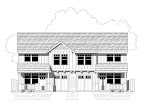Ever noticed a new house that tries to look old? Some look terribly fake. Some do a great job. But none of them quite grab the look. Driving around town, it's not hard to spot the infill lots that have brand new period houses on them. We can even tell the difference between a well preserved old house, a well remodeled old home, and a brand new "old" home. Why? What's the difference? The eyes always give it away. In this case, the windows. Windows are a big part of a home and they can have a big effect on the way the home looks.
What is the big difference between old and new home windows? Crappy white vinyl frames? Not necessarily as old windows are often painted white. Grids? Not all old windows had grids and newer windows have some passable grids. We tend to think it's depth. Ever look at an old window? It's part of the framing. Now look at a new window. It's tacked to the outside of the framing like a 'Post No Bills' sign. Am I right? Tell me I'm wrong.
The big difference is in the way window production has changed over the years. When the aluminum flange window arrived on the scene, it made window installation quicker and more forgiving. A non-square opening no longer had to be shimmed to accept an inset window. Now the window could be squared on top of the sheathing and interior trim would cover the other side of the error.
Even though the look has been lost to mass production processes, it's not too hard to bring the look back. The first option is with new inset windows. Sometimes touted as replacement windows, these wood or wood clad panes set inside the framing the way their ancestors used to. There is a price to be paid for these windows though as they are not economically on par with their face flange cousins.
The second option is to use the cheaper face flange windows but spend another 5 minutes on each opening. First, frame your opening to 3" larger than required. Then use a smaller 2x framing member to sub frame your main opening. If you are framing 2x6 walls, line it with 2x4. If you are framing double 2x4 walls, use a piece that is wide enough to cover your interior stud, your gap, and then a little. A 10" double 2x4 wall would require a 2x8 sub frame. Your flange window then mounts to this sub frame and voila! Your windows have the appearance of being integral to the framing instead of slapped on top. A little 5/4 trim around the edges and it's a work of art.
Another benefit to this approach is that your water management just got a lot easier. As long as you have a sloped sill on the outside and a planned drainage path, you're good for the long haul. The water above the window opening gets kicked out by a piece of Z flashing at the head trim.
C'mon, my grandma could do this!
Istockhouseplans is committed to quality design and we hope you'll extend this to your building. Contact us with any questions during your build process and we'll be happy to give you free consultation.
Tuesday, March 16, 2010
Subscribe to:
Post Comments (Atom)






No comments:
Post a Comment